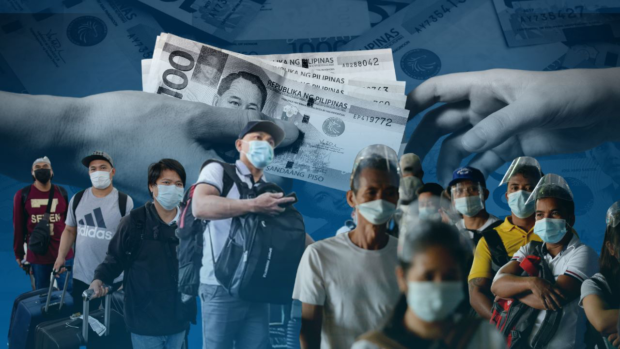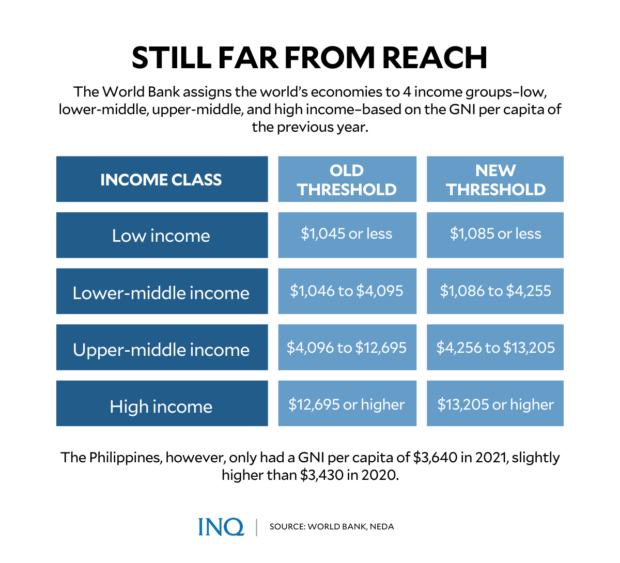Delayed or not, will higher PH income status mean better Filipino lives?
MANILA, Philippines—Since 2019, the year the Philippines was classified by the World Bank as a lower-middle income economy, the government has vowed that the country will “soon” reach upper-middle income status.
But what does such a status really mean?
The most recent promise was made by President Ferdinand Marcos Jr. when he addressed Filipinos last July, saying that his administration will bring the Philippines to a higher income status by 2024.
Looking back, Ernesto Pernia, who was head of the National Economic Development Authority (NEDA) in 2019, said the Philippines will advance to an upper-middle income status by 2020.
Then in July last year, NEDA, which was already headed by its new chief, Karl Kendrick Chua, said the country, through its key economic policies, will achieve higher income status by 2022.
Article continues after this advertisementBut like what happened to Pernia and Chua’s words, the new administration’s deadline of reaching an upper-middle income status for the Philippines by 2024 was moved to 2025 because of the sharp economic contraction in 2020 and the sharp depreciation of the peso this year.
Article continues after this advertisementREAD: PH moves target to become upper-middle-income status to 2025
Delayed
It was Marcos himself who stressed in his first State of the Nation Address that the Philippines will have a gross national income (GNI) per capita of $4,256 by 2024, indicating that the country will be able to achieve higher income status.
Then in his speech at the 77th session of the United Nations General Assembly on Sept. 21, Marcos said “despite the challenges of the pandemic and the global economic upheavals, we remain on track to reach upper middle-income status by next year.”
But last Dec. 17, Socioeconomic Planning Secretary Arsenio Balisacan revealed that the Philippines moved its target of reaching a higher income status from 2024 to 2025.
RELATED STORY: PH faces steeper climb to Marcos Jr.’s upper middle-income goal as WB further hikes threshold
This, as the country ran into setbacks this year, he said, stressing how the sharp economic contraction in 2020 and sharp depreciation of the peso, which sank to an all-time low of P59:$1 in October, affected the GNI.
Balisacan stated at the “Saturday News Forum” in Quezon City that the entry of the Philippines in the category of upper-middle income economies “will now be in 2025.”
However, he expressed confidence that the country’s GNI per capita will hit $4,456 by 2025 “because at that level of per capita income, that’s when we meet the threshold of joining upper-middle [income] economies.”
How are economies classified?
Based on data from World Bank, countries are assigned up to four income classes—low, lower-middle, upper-middle, and high-income—depending on the GNI per capita of the previous year.
“Countries are immediately reassigned on July 1 each year, based on the estimate of their GNI per capita for the previous calendar year. Income groupings remain fixed for the entire fiscal year,” it said.
Last year, a country with a GNI per capita of at least $1,045 or less was considered low-income, while lower-middle income economies were required to have at least $1,046 to $4,095 per capita GNI.
Then an economy with a GNI per capita of at least $4,096 to $12,695 was classified as upper-middle income, while high-income countries had to at least have $12,695 or higher GNI per capita.
This year, however, the thresholds for 2023 were revised, hiking the status requirement to $1,085 or less for low-income, $1,086 to $4,255 for lower-middle income, $4,256 to $13,205 for upper-middle income, and $13,205 or higher for high-income.
While the Philippines saw an increase in its GNI per capita from $3,430 in 2020 to $3,640 in 2021, last year’s GNI per capita, which is the income generated by a country’s residents within and outside its borders, is still below the pre-COVID level of $3,850.
The Philippines has been classified as a lower middle-income country ever since the World Bank came up with its classification scheme—whether internally in the early 1980s or as officially published since 1989.
As stated by the think tank Ibon Foundation, while the Philippines has remained lower middle-income over this time, at least 42 countries have actually already been reclassified as upper middle-income or even higher income economies since the late 1990s.
“In Southeast Asia, this includes Malaysia and Thailand which were reclassified as upper middle-income in 1992 and 2010, respectively,” Sonny Africa, the think tank’s executive director, said.
Closer look
The World Bank has been classifying economies based on their GNI per capita levels since 1989, with Africa explaining that the main motivation was to have an indicator for designating whether a member economy is or is not eligible to borrow.
“The World Bank settled on using GNI per capita as a proxy indicator for a country’s level of development or underdevelopment and, correspondingly, its need for support from the institution,” he said.
But while looking at the GNI per capita and its population seemed to be enough because the aspects of socio-economic wellbeing are anyway correlated with GNI per capita, Africa stressed that the scheme “can obscure more than it describes.”
“It will be grossly insensitive to hype an ‘upper-middle income’ classification according to the World Bank’s narrow scheme if the wellbeing of most Filipinos is very far from the ‘upper middle-income’ status that the term seems to imply.”
“The most obvious problem is that the average income per person which GNI per capita basically measures is so far removed from the lived experience of tens of millions of Filipinos,” Africa said.
As he stated, the country’s political and economic structures are so unequal that the benefits from economic activity, which boosts GNI, “are concentrated in an elite few and not distributed equally among 111 million Filipinos.”
“Most Filipinos struggle with low and insufficient incomes,” he stressed.
Left out
Ibon Foundation said being reclassified as upper middle income is “then not really something to aspire to in itself,” saying that it would be better to instead revisit economic policies that have kept the economy underdeveloped and most people poor.
It shared that for instance, the Bangko Sentral ng Pilipinas reported that over seven out of 10 families, or 72.5 percent, did not have any savings as of the third quarter of this year.
A Social Weather Stations survey, meanwhile, found eight out of ten families (79%) reporting themselves as poor (48 percent) or borderline poor (31 percent): “These are magnitudes of 19-20 million families out of the country’s some 25 million families,” according to SWS.
“Then last year, some 70 percent of families had meager incomes averaging just Php9,668 to Php25,245 monthly (first to seventh deciles),” as reflected in the Philippine Statistic Authority (PSA) 2021 Family Income and Expenditure Survey.
“GNI per capita completely fails to reflect the reality of persistently low family incomes and earnings; lack of secure and decent work; inadequate education, nutrition and health; poor housing; lack of clean water, sanitation and electricity; lack of assets; and pervasive vulnerability, exploitation and violence.”
“The distribution of income and all these other dimensions of poverty need to be considered in any classification of the country’s level of development,” Africa said.
“If anything, becoming classified as ‘upper middle income’ may even just be disguising how increasingly unequal the country is becoming and how many more are becoming left behind.”
READ: PH seen achieving upper middle-income status this year despite COVID-19
TSB

